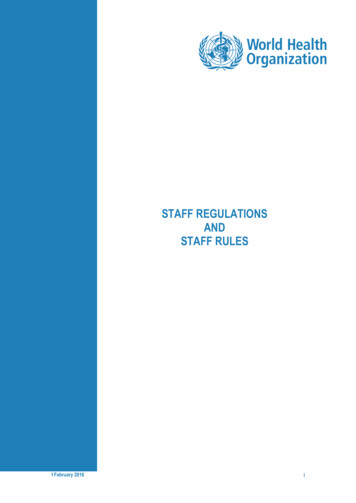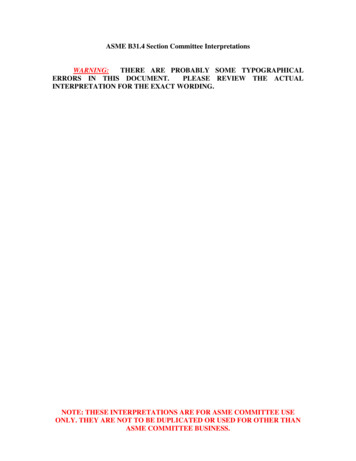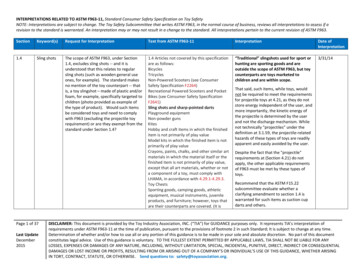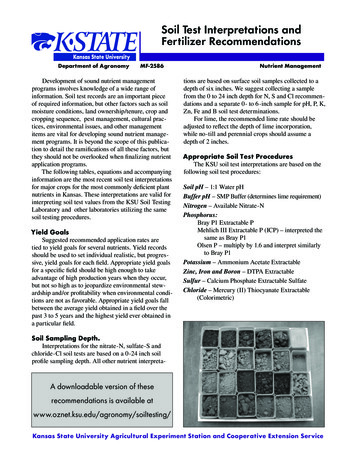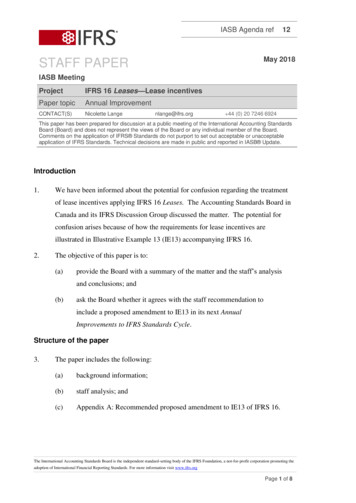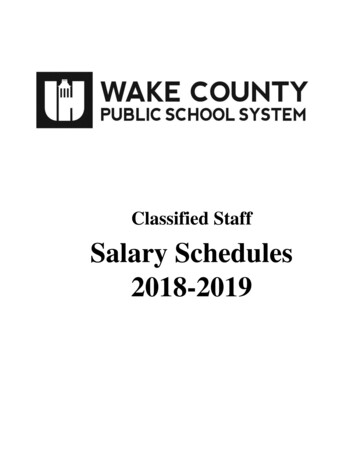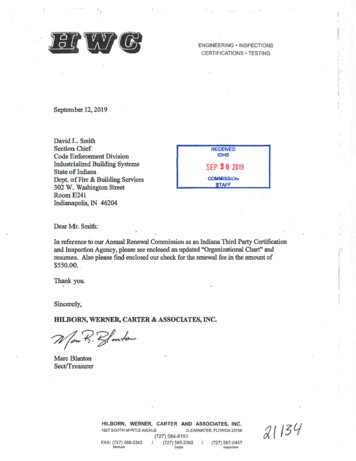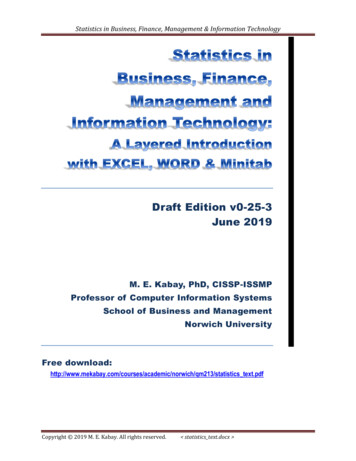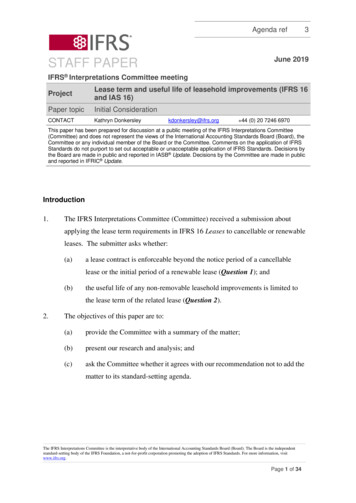
Transcription
Agenda ref3June 2019STAFF PAPERIFRS Interpretations Committee meetingProjectLease term and useful life of leasehold improvements (IFRS 16and IAS 16)Paper topicInitial ConsiderationCONTACTKathryn Donkersleykdonkersley@ifrs.org 44 (0) 20 7246 6970This paper has been prepared for discussion at a public meeting of the IFRS Interpretations Committee(Committee) and does not represent the views of the International Accounting Standards Board (Board), theCommittee or any individual member of the Board or the Committee. Comments on the application of IFRSStandards do not purport to set out acceptable or unacceptable application of IFRS Standards. Decisions bythe Board are made in public and reported in IASB Update. Decisions by the Committee are made in publicand reported in IFRIC Update.Introduction1.The IFRS Interpretations Committee (Committee) received a submission aboutapplying the lease term requirements in IFRS 16 Leases to cancellable or renewableleases. The submitter asks whether:(a)a lease contract is enforceable beyond the notice period of a cancellablelease or the initial period of a renewable lease (Question 1); and(b)the useful life of any non-removable leasehold improvements is limited tothe lease term of the related lease (Question 2).2.The objectives of this paper are to:(a)provide the Committee with a summary of the matter;(b)present our research and analysis; and(c)ask the Committee whether it agrees with our recommendation not to add thematter to its standard-setting agenda.The IFRS Interpretations Committee is the interpretative body of the International Accounting Standards Board (Board). The Board is the independentstandard-setting body of the IFRS Foundation, a not-for-profit corporation promoting the adoption of IFRS Standards. For more information, visitwww.ifrs.org.Page 1 of 34
Agenda ref3Structure of the paper3.This paper includes:(a)background information;(b)outreach;(c)staff analysis on Question 1—determination of lease term;(d)staff analysis on Question 2—determination of useful life of non-removableleasehold improvements; and(e)4.staff recommendation.There are two appendices to this paper:(a)Appendix A––proposed wording of the tentative agenda decision.(b)Appendix B—submission.Background informationComponents of lease term5.When considering the fact pattern in the submission, and the analysis in this paper, wethink it is helpful to keep in mind the following:(a)the non-cancellable period of a lease is any period during which the lesseecannot terminate the contract (paragraph B35 of IFRS 16). Consequently,any non-cancellable period in effect sets a minimum lease term.(b)lease term is the non-cancellable period of a lease, together with anyoptional periods that the lessee is reasonably certain to use (paragraph 18 ofIFRS 16); and(c)the enforceable period of a lease is the period for which enforceable rightsand obligations exist between the lessee and the lessor (as described inparagraph B34 of IFRS 16). To be part of a contract, any optional periodsIFRS 16 and IAS 16–Lease term and useful life of leasehold improvements Initial ConsiderationPage 2 of 34
Agenda ref3that are included in the lease term must also be enforceable. Consequently,the enforceable period in effect sets a maximum lease term.6.In a simple contract with no optional periods, the non-cancellable period, lease term,and enforceable period of a lease may all be the same. The diagram below depicts amore complex contract, with multiple optional periods:7.Consequently, in determining the lease term, an entity first determines the enforceableperiod and non-cancellable period of the contract. It then determines where—withinthe range between the non-cancellable period (minimum lease term) and theenforceable period (maximum lease term)—the lease term falls.The fact pattern8.The submission describes two fact patterns:(a)cancellable lease: an entity enters into a lease contract that does not specifya particular contractual term and continues indefinitely until either partygives notice to terminate. When either the lessee or lessor gives notice, thelease continues for a period of less than 12 months (‘notice period’) untiltermination. Neither party is obliged to make a contractual payment ontermination.(b)renewable lease: an entity enters into a lease contract with a specifiedinitial period, which renews indefinitely unless terminated by either thelessee or lessor.IFRS 16 and IAS 16–Lease term and useful life of leasehold improvements Initial ConsiderationPage 3 of 34
Agenda ref9.3The submitter asks two questions:(a)Question 1: how to determine the lease term for these contracts.Specifically, the submitter asks whether an entity considers economic costsother than contractual termination payments when determining theenforceable period of the lease. Such costs might relate, for example, toabandoning or dismantling leasehold improvements.(b)Question 2: whether the useful life of any non-removable leaseholdimprovements (such as fixtures and fittings) is limited to the notice periodof a cancellable lease or the initial period of a renewable lease. Thesubmitter notes that this question is particularly important if the leasecontract is not enforceable beyond the notice period of a cancellable leaseor the initial period of a renewable lease (Question 1).10.Appendix B to this paper reproduces the submission, which provides furtherbackground information.11.In the analysis that follows we refer to the notice period of a cancellable lease.However, the analysis applies equally to the initial period of a renewable lease.Outreach12.We decided not to perform outreach on this request for a number of reasons:(a)We are already aware that the determination of the lease term could have amaterial effect on the many entities that enter into lease contracts. TheBoard’s effects analysis on IFRS 16 identified the prevalence of leases andthe expected widespread effect of recognising all leases (other than shortterm leases and leases of low-value assets) on the balance sheet. A lessee isrequired to apply judgement in determining the lease term when a contractcontains optional periods. We are also aware that, for particular leases suchas property leases, the potential right-of-use asset and lease liability relatingto periods beyond the notice period of a cancellable lease can be material.Consequently, we did not need to perform outreach to conclude thatIFRS 16 and IAS 16–Lease term and useful life of leasehold improvements Initial ConsiderationPage 4 of 34
Agenda ref3determining the enforceable period and lease term for a cancellable leasecould have a material effect on entities affected.(b)The submission relates to the application of IFRS 16 and, in the light of itseffective date (annual reporting periods beginning on or after 1 January2019), there is likely to be little observable practice at this time. Thedetermination of the lease term in IFRS 16 is similar to that in IAS 17 Leases(ie both Standards require an entity to apply judgement in assessing whethera lessee is ‘reasonably certain’ to exercise an extension option or not toexercise a termination option). We therefore considered whether it would bebeneficial to perform outreach on the application of IAS 17’s lease termrequirements. However, we decided not to do this because we think suchoutreach may not give a complete and representative picture in the context ofIFRS 16. This is for two reasons:(i)IAS 17 and IFRS 16 contain different words with respect to thenon-cancellable period of a lease—IAS 17 defined the term‘non-cancellable lease’, whilst IFRS 16 refers an entity to thedefinition of a contract and determining the period for which alease is enforceable. The non-cancellable period of a lease isfundamental to the questions asked by the submitter.(ii)We are aware that many entities expect to apply the lease termrequirements in IFRS 16 with more rigour than was previouslythe case applying IAS 17. This is because, applying IAS 17, themajority of lease contracts were classified as operating leasesand were not recognised on a lessee’s balance sheet. Therefore,for the majority of leases, the length of the lease term did notaffect the primary financial statements.IFRS 16 and IAS 16–Lease term and useful life of leasehold improvements Initial ConsiderationPage 5 of 34
Agenda ref3Staff analysis on Question 1: Determination of lease termRequirements in IFRS 1613.Paragraph 18 of IFRS 16 requires an entity to determine the lease term as the noncancellable period of a lease, together with both:(a)periods covered by an option to extend the lease if the lessee is reasonablycertain to exercise that option; and(b)periods covered by an option to terminate the lease if the lessee isreasonably certain not to exercise that option.14.Paragraph BC156 explains the Board’s objective when developing the lease termrequirements:‘In the IASB’s view, the lease term should reflect an entity’sreasonable expectation of the period during which theunderlying asset will be used because that approach providesthe most useful information ’.Enforceable period15.Paragraphs B34 and B35 of IFRS 16 contain application guidance about the lease termand non-cancellable period of a lease:B34 In determining the lease term and assessing the length ofthe non-cancellable period of a lease, an entity shall apply thedefinition of a contract and determine the period for which thecontract is enforceable. A lease is no longer enforceable whenthe lessee and the lessor each has the right to terminate thelease without permission from the other party with no more thanan insignificant penalty.B35 If only a lessee has the right to terminate a lease, that rightis considered to be an option to terminate the lease available tothe lessee that an entity considers when determining the leaseterm. If only a lessor has the right to terminate a lease, the non-IFRS 16 and IAS 16–Lease term and useful life of leasehold improvements Initial ConsiderationPage 6 of 34
Agenda ref3cancellable period of the lease includes the period covered bythe option to terminate the lease.16.Appendix A of IFRS 16 notes that the term “contract” is defined in other Standards andused in IFRS 16 with the same meaning. The Appendix goes on to quote the definitionof “contract” from Appendix A to IFRS 15 Revenue from Contracts with Customers:An agreement between two or more parties that createsenforceable rights and obligations17.Paragraphs BC127-BC129 explain the Board’s rationale for these requirements:BC127 For the purposes of defining the scope of IFRS 16, theIASB decided that a contract would be considered to exist onlywhen it creates rights and obligations that are enforceable. Anynon-cancellable period or notice period in a lease would meetthe definition of a contract and, thus, would be included as partof the lease term. To be part of a contract, any options to extendor terminate the lease that are included in the lease term mustalso be enforceable; for example the lessee must be able toenforce its right to extend the lease beyond the non-cancellableperiod. If optional periods are not enforceable, for example, ifthe lessee cannot enforce the extension of the lease without theagreement of the lessor, the lessee does not have the right uently, by definition, there is no contract beyond thenon-cancellable period (plus any notice period) if there are noenforceable rights and obligations existing between the lesseeand lessor beyond that term. In assessing the enforceability ofa contract, an entity should consider whether the lessor canrefuse to agree to a request from the lessee to extend the lease.BC128 Accordingly, if the lessee has the right to extend orterminate the lease, there are enforceable rights and obligationsbeyond the initial non-cancellable period and the parties to thelease would be required to consider those optional periods intheir assessment of the lease term. In contrast, a lessor’s rightIFRS 16 and IAS 16–Lease term and useful life of leasehold improvements Initial ConsiderationPage 7 of 34
Agenda ref3to terminate a lease is ignored when determining the lease termbecause, in that case, the lessee has an unconditionalobligation to pay for the right to use the asset for the period ofthe lease, unless and until the lessor decides to terminate thelease.BC129 The IASB considered whether applying enforceability toleases in this way might encourage entities to add a clause to alease that does not have economic substance, for example,stating that the lease could be cancelled at any point, knowingthat, in practice, it would not be cancelled. However, the IASBis of the view that such clauses are unlikely to be added becausethere often is an economic disincentive for either the lessor orlessee to agree to their inclusion. For example, if a lessor haspriced a contract assuming that the lessee will not cancel thecontract, including such a clause would put the lessor at risk ofbeing exposed to higher residual asset risk than had beenanticipated when pricing the contract, which would be aneconomic disincentive for the lessor. Conversely, if the lessorhas priced the contract assuming that the lessee will or maycancel the contract, the lessee would be likely to have to payhigher rentals to compensate the lessor for taking on moreresidual asset risk. Those higher rentals would be an economicdisincentive for the lessee, if it does not intend to cancel thecontract.Optional periods18.Paragraphs 19 and B37-B40 of IFRS 16 contain requirements about the assessment ofoptional periods. Paragraph 19 requires an entity to ‘consider all relevant facts andcircumstances that create an economic incentive for the lessee to exercise the option toextend the lease, or not to exercise the option to terminate the lease’. Paragraph B37states that factors to consider in this assessment include, but are not limited to:(a)contractual terms and cond
Lease term and useful life of leasehold improvements (IFRS 16 and IAS 16) Paper topic Initial Consideration CONTACT Kathryn Donkersley kdonkersley@ifrs.org 44 (0) 20 7246 6970 This paper has been prepared for discussion at a public meeting of the IFRS Interpretations Committee (Committee) and does not represent the views of the International Accounting Standards Board (Board), the Committee .
